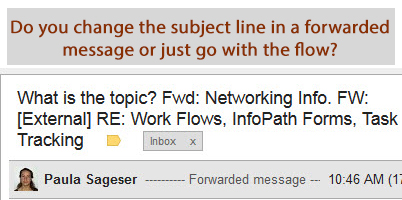Some days (well, maybe most days) we all dread opening our email. Very few people I know can say they keep up with incoming email messages. Most barely keep their head above the flood, and many end up drowning in it. The same goes for the flood of information hitting us via social media. When we are overwhelmed by communication, how do we decide what information floats into our brains versus sinks? In this world of massive inboxes and floods of messages, a writer’s ability to quickly grab the attention of our readers is key. Once we have that brief moment of a reader’s attention, writers should take care not to confuse or anger readers with misleading information. So, how do we do this?
I am often the recipient of messages forwarded to me as part of an email string. One person started a message, brought in a few other people, several people started to comment or reply, and the message wandered. Many times I find myself confused when the subject of the original message has nothing to do with the current topic of the conversation. The message was “hijacked” and may even include background details that I need to know, but it has changed significantly from its original topic. What becomes frustrating is when the subject line didn’t change along with the topic change. Because of ineffective subject lines, I have found myself ignoring a long string of messages thinking the topic didn’t involve me, only to find I had a key part in the discussion. The confusion gets worse when I save messages for future reference, then can’t find what I’m looking for because the subject line is not on topic.
In professional situations it is important that every message we send lets our readers know what we want them to do or know and if there are deadlines involved, what the timing of the message is. To make it past those quick scans and filters, our subject lines or message headings should clearly signal what kind of message we’re sending. Can we include a brief summary of what they need to do/know and deadlines/dates right up front? Our subject line/heading is all most people read when scanning through a flood of messages, so it better be able to grab attention. Keeping the subject relevant is equally important to holding readers and keeping them during a cycle of replies.
There are tools available to learn how to organize your writing and plan out your messages. I recommend everyone have a good style guide (or two). While we may not think of ourselves primarily as writers, the size of our email inbox(es) would indicate that all of us are. The Franklin Covey Style Guide For Business and Technical Communication is just one of the many good options out there. I especially appreciate its advice specific to using and managing email effectively. Another very popular guide is The Chicago Manual of Style and it even has an online version. Whether you use a guide or not, if you take the time to design and plan, your messages are less likely to be lost or ignored.
If you think in terms of online search and search engine tools, then you begin to understand the importance of a good title, backed up by consistent and relevant content. What is effective and useful for your readers can (and should!) be equally effective and useful for the brief snippets that appear in search engines.
In summary, remember to grab the attention of your readers with the purpose, do/know, deadline/date of your subject lines. Help your readers manage the flood of information that hits them by providing clues to sort, categorize, and prioritize and we will all be more effective communicators.

